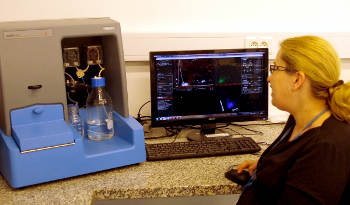Nov 6 2013
NanoSight reports on how Nanoparticle Tracking Analysis, NTA, is being implemented for the characterization of various inorganic nanopowders and colloids synthesized in the Institute of High Pressure Physics at the Polish Academy of Sciences in Warsaw.
 Agnieszka Opalinska uses the NS500 system to characterize nanopowders & colloids at the Polish Academy of Sciences.
Agnieszka Opalinska uses the NS500 system to characterize nanopowders & colloids at the Polish Academy of Sciences.
The Institute of High Pressure Physics (IHPP) was founded in 1972 by the Polish Academy of Sciences. The original focus was on high-pressure studies of semiconductors. Now, research covers ceramics, HTc superconductors, biological materials (high-pressure studies of protein folding, and high pressure food processing) and the plasticity of metals (hydroextrusion). The common axis of these studies is the use of high pressure, both as a research tool (a perturbation like temperature or magnetic field) and as a technological method (high-pressure sintering, high-pressure growth of crystals).
Agnieszka Opalinska is a research chemist working on the synthesis and practical applications of nanopowders for use in medicine, optics, optoelectronics, pharmacy and cosmetics. The Institute has developed a microwave, solvothermal technology which has enabled the group to very rapidly obtain homogenous and phase-pure nanoparticles including hydroxyapatite, zinc oxide and zirconium oxide. The size and shape of these nanopowders are easy to manipulate and may be functionalized with organic molecules. With a specialty in the preparation of colloidal solutions too, the group needs accurate and easy-to-use methods of particle characterization.
Proper characterization of nanostructure of powders is the key stage for the process. The Institute makes several measurements including nanopowder morphology, density, specific surface area, phase composition and crystalite size, all of which are made on dry powder samples. For the past two years, the Institute has used both NTA and DLS (Dynamic Light Scattering) to produce complementary sizing results. However, when making the colloidal studies, NTA has a distinct advantage. Ms. Opalinska says "using NTA also gives us the concentration of particles. We like the use of video to be able to visualize the agglomeration process and to help us track the kinetics of the process."
To find out about the company and to learn more about particle characterization using NanoSight's unique Nanoparticle Tracking Analysis solutions, visit www.nanosight.com and register to receive the next issue of NanoTrail, the company's electronic newsletter.
About NanoSight
NanoSight's "Nanoparticle Tracking Analysis" (NTA) detects and visualizes populations of nanoparticles in liquids down to 10 nm, dependent on material, and measures the size of each particle from direct observations of diffusion. Additionally, NanoSight measures concentration and a fluorescence mode differentiates suitably-labelled particles within complex background suspensions. Zeta potential measurements are similarly particle-specific.
This real-time data gives insight into the kinetics of protein aggregation and other time-dependent phenomena in a qualitative and quantitative manner. NTA has a growing role in biodiagnostics, being proven in detection and speciation of extracellular vesicles.
NanoSight has installed more than 600 systems worldwide and its technology is validated by 900+ third party papers citing NanoSight results. For more information, visit www.nanosight.com.
NanoSight is a Malvern Instruments company
About Malvern Instruments
Malvern provides the materials and biophysical characterization technology and expertise that enables scientists and engineers to understand and control the properties of dispersed systems. These systems range from proteins and polymers in solution, particle and nanoparticle suspensions and emulsions,
through to sprays and aerosols, industrial bulk powders and high concentration slurries. Used at all stages of research, development and manufacturing, Malvern's materials characterization instruments provide critical information that helps accelerate research and product development, enhance and maintain product quality and optimize process efficiency.
Our products reflect Malvern's drive to exploit the latest technological innovations and our commitment to maximizing the potential of established techniques. They are used by both industry and academia, in sectors ranging from pharmaceuticals and biopharmaceuticals to bulk chemicals, cement, plastics and polymers, energy and the environment.
Malvern systems are used to measure particle size and count, particle shape, zeta potential, protein charge, molecular weight, mass, size and conformation, rheological properties and for chemical identification, advancing the understanding of dispersed systems across many different industries and applications.
Headquartered in Malvern, UK, Malvern Instruments has subsidiary organizations in all major European markets, North America, Mexico, China, Japan and Korea, a joint venture in India, a global distributor network and applications laboratories around the world. www.malvern.com.